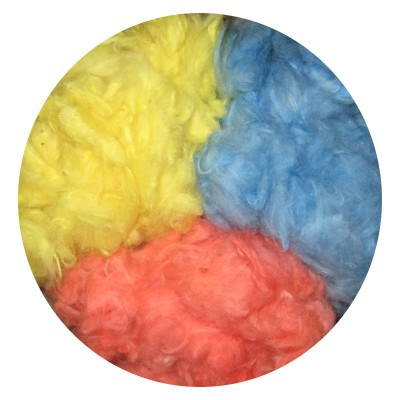 Color. I learned to work with color as an art student, when I took painting classes. I was fortunate to have an eye for color, so that mixing it came easily to me. I could match any color almost instinctively.
Color. I learned to work with color as an art student, when I took painting classes. I was fortunate to have an eye for color, so that mixing it came easily to me. I could match any color almost instinctively.Dyes are different. At first I wondered why my Procion MX starter kit came with red, blue, yellow, black, turquoise, and fuchsia. After experimenting, I've learned some things. I've already shared a little of that with you, but this post is a better record of what I've done and learned so far.
Using my unbleached cotton lint (photo top left), I started with green, using the "Shamrock" recipe I found on this Jacquard chart.
 So what would happen if I mix the proportions up a bit?
So what would happen if I mix the proportions up a bit? OK. Not a lot of difference, still they are pretty greens. But why the turquoise? Yellow and blue make green, right? What would happen if I just mixed the dyes like paints?
OK. Not a lot of difference, still they are pretty greens. But why the turquoise? Yellow and blue make green, right? What would happen if I just mixed the dyes like paints? Interesting. Green #3 is a nice green, not as clear looking as greens 1 and 2.
Interesting. Green #3 is a nice green, not as clear looking as greens 1 and 2.Next, purple:
 Switching proportions made a big difference this time....
Switching proportions made a big difference this time.... But why fuchsia? Why not red?
But why fuchsia? Why not red? Um, yuck(?). This purple reminds me of a lighter version of the color of my home canned Muscadine grape jelly after it's aged a bit.
Um, yuck(?). This purple reminds me of a lighter version of the color of my home canned Muscadine grape jelly after it's aged a bit.One problem with purple #3 is that the red (MX-GBA) is not a pure hue. According to Paula Burch's PMX dye purity chart, this red is actually a mixture. I'm not sure what colors it's made of, but my guess would be yellow. Not only because Earth Guild calls it "Warm Red," but because yellow, being the opposite (compliment) of blue, would tend to muddy the purple.
Ah, but at least the recipe for orange ("Tangerine") is familiar color mixing territory:

 A subtle difference from switching the proportions. But what if I substitute fuchsia for red? What happens then?
A subtle difference from switching the proportions. But what if I substitute fuchsia for red? What happens then? Well..... it's pretty but it's not exactly what I would call orange!
Well..... it's pretty but it's not exactly what I would call orange!One thing I have learned from reading Deb Menz's Color In Spinning, is that all dyes have undertones. That's what the MX codes indicate in part, the undertones. According to this article (also by Paula Burch), the code letters after the MX stand for G = gelb, German for yellow, B = blau or blue, and R = rot or red. These undertones influence the outcome, and some work together better than others.
Because of those undertones, I could go on and on, playing with the colors and proportions. But I have other things I want to explore.
So there you have it. The beginning of my experiential knowledge base. I feel like I've got a good start.
Posted 28 June 2008 at http://leighsfiberjournal.blogspot.com
Related Posts:
1st Procion MX Dye Experiments - working with the primaries
2nd Procion MX Dye Experiments - experimenting with color mixing
Procion MX Fuchsia - information about
Procion MX Turquoise - information about
Procion MX Exhaust Experiments - You tell me!
























